
Original Link: https://www.anandtech.com/show/2836
AMD Athlon II X4 620 & 630: The First $99 Quad Core CPU
by Anand Lal Shimpi on September 16, 2009 12:00 AM EST- Posted in
- CPUs
How does AMD respond to Lynnfield? Is it by drastically cutting prices on Phenom II? Nope. By introducing the world’s first quad-core processor to debut at $99. Now that’s cool.

It’s called the Athlon II X4 and its existence shouldn’t be any surprise. AMD quietly announced it along with the Athlon II X2 line.

Today we get two models: the Athlon II X4 630 and the Athlon II X4 620, priced at $122 and $99 respectively. The only difference between the two is clock speed; the 630 runs at 2.8GHz while the 620 runs at 2.6GHz. These are both AM3 chips meaning they'll work in AM3 motherboards with DDR3 memory or AM2+ boards with DDR2 memory.
| Processor | Clock Speed | L2 Cache | L3 Cache | TDP | Price |
| AMD Phenom II X4 965 BE | 3.4GHz | 2MB | 6MB | 140W | $245 |
| AMD Phenom II X4 955 BE | 3.2GHz | 2MB | 6MB | 125W | $245 |
| AMD Phenom II X4 945 | 3.0GHz | 2MB | 6MB | 125W | $225 |
| AMD Phenom II X3 720 BE | 2.8GHz | 1.5MB | 6MB | 95W | $145 |
| AMD Phenom II X2 550 BE | 3.1GHz | 1MB | 6MB | 80W | $105 |
| AMD Athlon II X4 630 | 2.8GHz | 2MB | 0MB | 95W | $122 |
| AMD Athlon II X4 620 | 2.6GHz | 2MB | 0MB | 95W | $99 |
| AMD Athlon II X2 250 | 3.0GHz | 2MB | 0MB | 65W | $87 |

This isn’t a harvested Phenom II nor is it a pair of Athlon II X2s, instead it looks like we have a brand new die on our hands (some Athlon II X4s will be crippled Phenom IIs but AMD insists that the new die will be used). The Athlon II X4 has four cores on a single die, but unlike the Athlon II X2 each core only has a 512KB L2 per core. You can tell by the die shot that the core-to-cache ratio is much higher than on the X2:
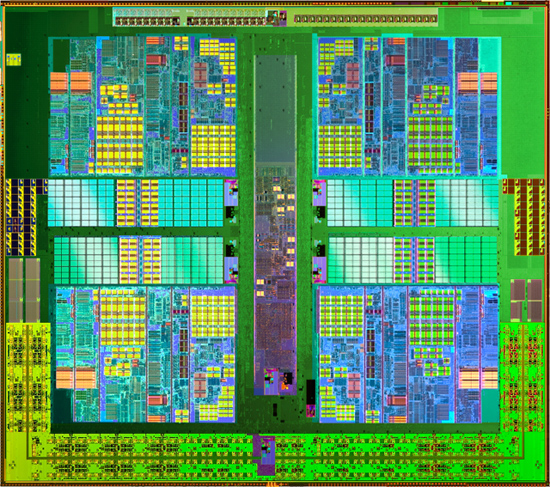
The 45nm Athlon II X4 Propus die
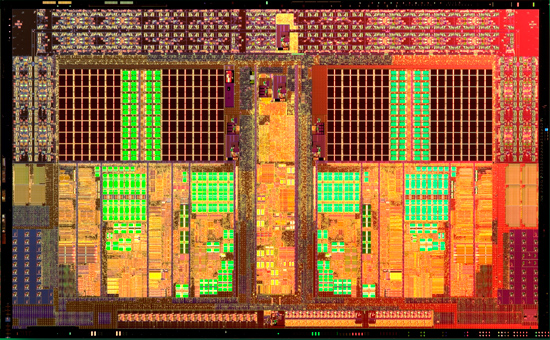
The 45nm Athlon II X2 die (note the larger L2 per core)
Like the rest of the Athlon II lineup there is no L3 cache. This helps keep the die small (and affordable) but also hurts performance:
| Processor | SYSMark 2007 Overall | E-Learning | Video Creation | Productivity | 3D |
| AMD Phenom II X4 920 (2.8GHz) | 173 | 151 | 212 | 167 | 167 |
| AMD Athlon II X4 630 (2.8GHz) | 157 | 128 | 221 | 131 | 162 |
| % of Phenom II X4 | 91% | 85% | 104% | 78% | 97% |
At the same clock speed the Athlon II X4 should offer roughly 90% of the performance of a Phenom II X4.
| Processor | Cores | Manufacturing Process | L1 Cache | L2 Cache | L3 Cache | Die Size | Transistor Count |
| AMD Phenom II X4 | 4 | 45nm | 128KB per core | 512KB per core | 6MB | 258 mm2 | 758M |
| AMD Athlon II X4 | 4 | 45nm | 128KB per core | 512KB per core | 0MB | 169 mm2 | 300M |
| AMD Athlon II X2 | 2 | 45nm | 128KB per core | 1MB per core | 0MB | 117 mm2 | 234M |
| Intel Core 2 Quad Q8xxx | 4 | 45nm | 64KB per core | 4MB | 0MB | 164 mm2 | 456M |
The price is unbeatable. If we ignore the 630 for a moment, the Athlon II X4 620 is by far the cheapest route to four cores on the market. Intel’s most affordable quad-core is the Core 2 Quad Q8200 at $163, while AMD would previously charge you $163 for a Phenom X4 9600B. This is where the AM3/AM2+ compatibility play really helps out. Motherboard/memory costs are as cheap as possible thanks to AMD's incredible socket flexibility.

And just in case you’re wondering, yes, the Athlon II X4 620 actually delivers performance competitive with the Q8200 but for 60% of the cost. It’s not all that clear cut, there are some cases where the 620 is faster but others where the Q8200 is much faster. On average it ends up being a wash but you’ll want to pay attention to the coming pages to see how the cookie crumbles as it does vary from test to test.
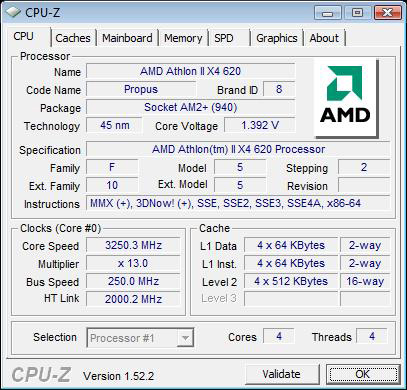
Codename Propus
Overclocking isn't unfortunately as good as the Phenom IIs; the result of a conscious design decision or simply the early nature of the Propus die. That being said, without a single extra millivolt I was able to hit 3.25GHz on my Athlon II X4 620 sample - making it even more valuable. Extra voltage proved mostly useless, I could only approach 3.4GHz with an extra 300mV.
Let’s see, have I thoroughly ruined the surprise? Check. Now let’s get to the tests.
The Test
| Motherboard: | Intel DX58SO (Intel X58) Intel DX48BT2 (Intel X48) Gigabyte GA-MA790FX-UD5P (AMD 790FX) |
| Chipset: | Intel X48 Intel X58 AMD 790FX |
| Chipset Drivers: | Intel 9.1.1.1015 (Intel) AMD Catalyst 8.12 |
| Hard Disk: | Intel X25-M SSD (80GB) |
| Memory: | Qimonda DDR3-1066 4 x 1GB (7-7-7-20) Corsair DDR3-1333 4 x 1GB (7-7-7-20) Patriot Viper DDR3-1333 2 x 2GB (7-7-7-20) |
| Video Card: | eVGA GeForce GTX 280 |
| Video Drivers: | NVIDIA ForceWare 180.43 (Vista64) NVIDIA ForceWare 178.24 (Vista32) |
| Desktop Resolution: | 1920 x 1200 |
| OS: | Windows Vista Ultimate 32-bit (for SYSMark) Windows Vista Ultimate 64-bit |
SYSMark 2007 Performance
Our journey starts with SYSMark 2007, the only all-encompassing performance suite in our review today. The idea here is simple: one benchmark to indicate the overall performance of your machine.
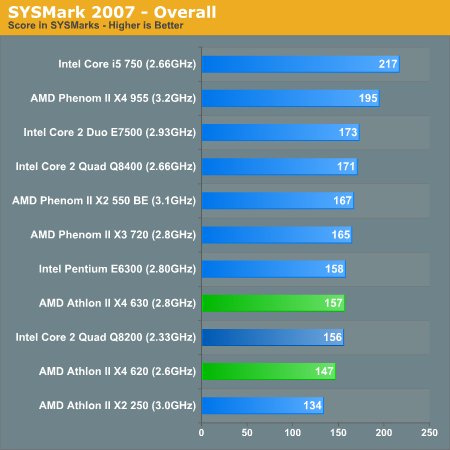
If we only look at the AMD numbers in this chart, there's a pretty nice lineup going on here. The Athlon II X2 250 is slower than the Athlon II X4 620/630, which is slower than the Phenom II X3 730 and all are slower than the Phenom II X4 955. The performance lines up with the pricing, so all is good.
The problem with these cheap quad-cores has always been that you give up a lot in order to get four cores at a low price. The Athlon II X4 appears to break the mold however. The Athlon II X4 620 is priced at $99 and it performs like a $99 CPU. With the exception of the Core 2 Duo E7500 whose high clock speed makes it do unsually well here, the 620 is balanced. You get a reasonably high clock speed and enough cache to be competitive, both at a good price.
You'll see in the individual tests below that performance varies between competitive and underwhelming depending on the task. Anything that can take advantage of four cores does well, otherwise the smaller L2s of the Athlon II X4 hurt it a bit.
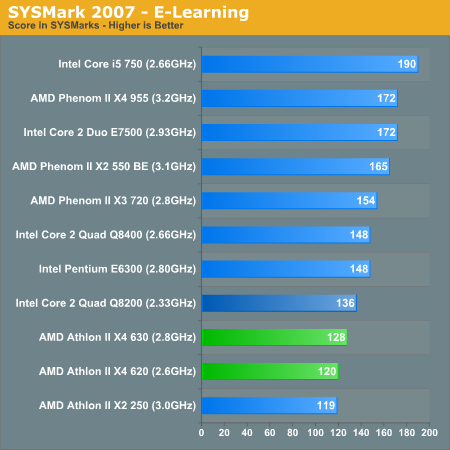
In applications that aren't well threaded, you'll see the Athlon II X4 perform less than stellar - but the same is true for all lower end quad-core CPUs. Even the Q8200 is outperformed by the E6300 here. Situations like this are validation for Intel's aggressive turbo modes on Lynnfield.
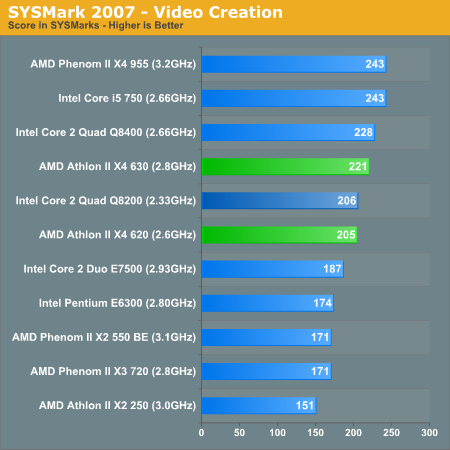
Any strenuous video encoding however will seriously favor the Athlon II X4. Here we find the $99 620 tying the Core 2 Quad Q8200, and the 630 outperforming it - all at a lower price.
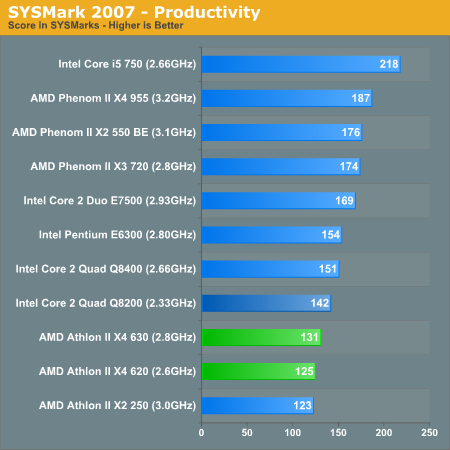
We're back to needing higher clock speeds and larger caches to compete. Being a quad-core processor isn't easy.

Adobe Photoshop CS4 Performance
To measure performance under Photoshop CS4 we turn to the Retouch Artists’ Speed Test. The test does basic photo editing; there are a couple of color space conversions, many layer creations, color curve adjustment, image and canvas size adjustment, unsharp mask, and finally a gaussian blur performed on the entire image.
The whole process is timed and thanks to the use of Intel's X25-M SSD as our test bed hard drive, performance is far more predictable than back when we used to test on mechanical disks.
Time is reported in seconds and the lower numbers mean better performance. The test is multithreaded and can hit all four cores in a quad-core machine.

Photoshop performance is actually very good on these chips, the extra cores help make them faster than even a Phenom II X3 720. For $99 you're getting better Photoshop performance than even more expensive dual core processors.
The Pentium E6300 isn't competitive here, despite being Intel's closest priced processor. The Q8200 is faster than both of these options, but it's also more expensive. Again, AMD priced the 620 on point.
DivX 8.5.3 with Xmpeg 5.0.3
Our DivX test is the same DivX / XMpeg 5.03 test we've run for the past few years now, the 1080p source file is encoded using the unconstrained DivX profile, quality/performance is set balanced at 5 and enhanced multithreading is enabled:
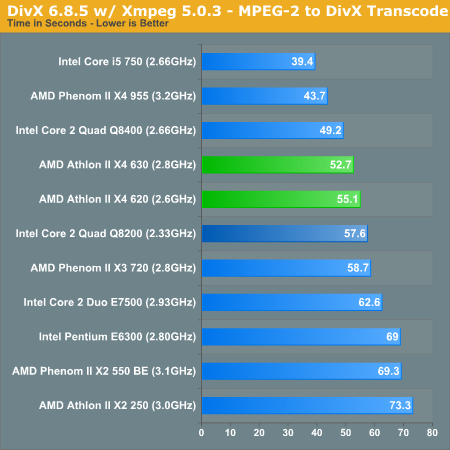
Four cores and you're good to go with video encoding. The Athlon II X4s are faster than the Q8200 and even the Phenom II X3 720. Intel doesn't have anything that offers better performance at $99 from a video encoding standpoint.
x264 HD Video Encoding Performance
Graysky's x264 HD test uses the publicly available x264 codec (open source implementation of H.264) to encode a 4Mbps 720p MPEG-2 source. The focus here is on quality rather than speed, thus the benchmark uses a 2-pass encode and reports the average frame rate in each pass.
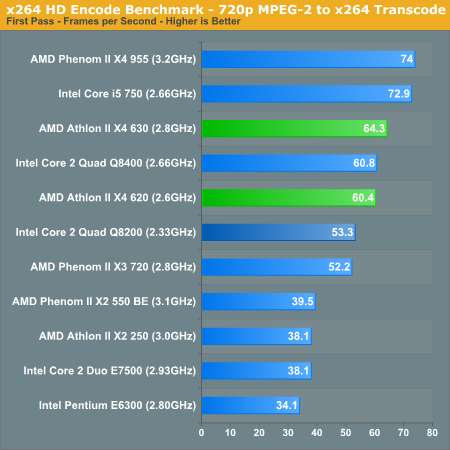
The Athlon II X4 continues to beat up on more expensive chips. The Q8200 and the E7500 don't stand a chance. Only the Phenom II X4 and Core i5 are faster.
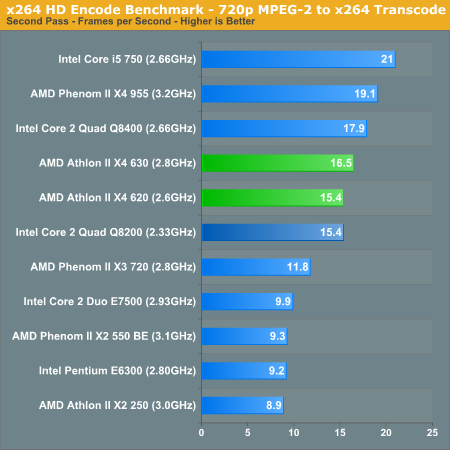
The Core 2 Quad Q8200 is only able to match the Athlon II X4 620 in performance here. While I'm used to writing that AMD needs to adjust prices downward, here the pressure falls on Intel.
Windows Media Encoder 9 x64 Advanced Profile
In order to be codec agnostic we've got a Windows Media Encoder benchmark looking at the same sort of thing we've been doing in the DivX and x264 tests, but using WME instead.

The Athlon II X4s round up our video encoding tests in the lead. At $99 you can't buy a better quad-core processor, or even dual-core for that matter if you're going to be encoding video.
3dsmax 9 - SPECapc 3dsmax CPU Rendering Test
Today's desktop processors are more than fast enough to do professional level 3D rendering at home. To look at performance under 3dsmax we ran the SPECapc 3dsmax 8 benchmark (only the CPU rendering tests) under 3dsmax 9 SP1. The results reported are the rendering composite scores:
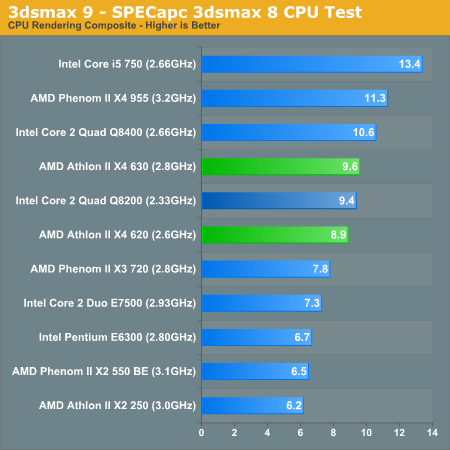
Offline 3D rendering should be another safe haven for the Athlon II X4. Core count matters and that's what AMD delivers. At $25 per core the Athlon II X4 620 is faster than even the X3 720. It's of course faster than any dual-core CPU in its price range, including the more expensive E7500. Intel's Core 2 Quad Q8200 is around 6% faster but costs 60% more.
Cinebench R10
Created by the Cinema 4D folks we have Cinebench, a popular 3D rendering benchmark that gives us both single and multi-threaded 3D rendering results.
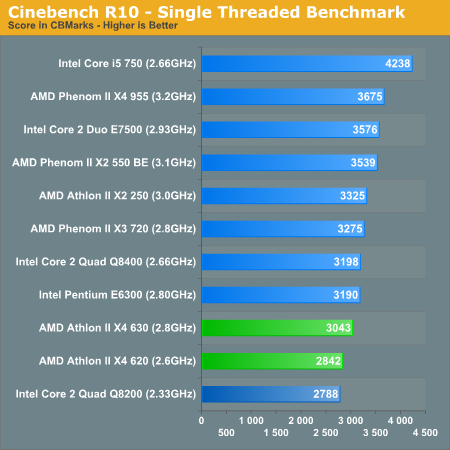
Single threaded performance is where the Athlon II X4 suffers the most. It's competitive but still slower than cheaper dual-core CPUs. This is the classic trade off for all pre-Lynnfield quad-core CPUs, you give up single threaded performance for multi-threaded performance. Luckily for AMD, Intel's Core 2 Quads suffer the same fate. While the Athlon IIs find themselves at the bottom of this chart, the Q8200 is the slowest chip here.
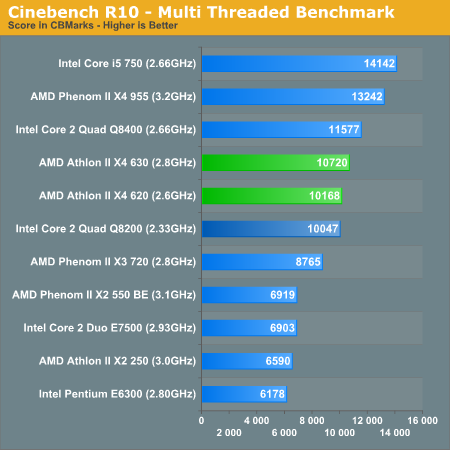
Turn up the thread count and the Athlon II shines once more. Again, the 620 is about the same speed as the Q8200, but slower than the Q8400. Just where it needs to be.
POV-Ray 3.73 beta 23 Ray Tracing Performance
POV-Ray is a popular, open-source raytracing application that also doubles as a great tool to measure CPU floating point performance.
I ran the SMP benchmark in beta 23 of POV-Ray 3.73. The numbers reported are the final score in pixels per second.
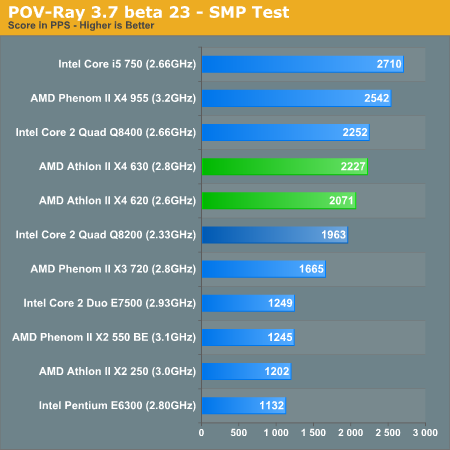
At this point I couldn't write a more competitive position for AMD. The Athlon II X4 continues to do very well in our 3D rendering tests.
Blender 2.48a
Blender is an open source 3D modeling application. Our benchmark here simply times how long it takes to render a character that comes with the application.
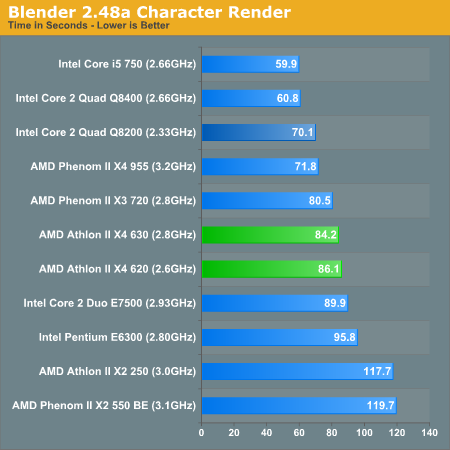
Our Blender test has traditionally favored Intel architectures, and here we see the first signs of the Athlon II X4 not being able to keep up. The Phenom II X3 720 and Core 2 Quad Q8200 are both faster, but compared to Intel's similarly priced dual-core offerings AMD is still quicker.
Microsoft Excel 2007
Excel can be a very powerful mathematical tool. In this benchmark we're running a Monte Carlo simulation on a very large spreadsheet of stock pricing data.
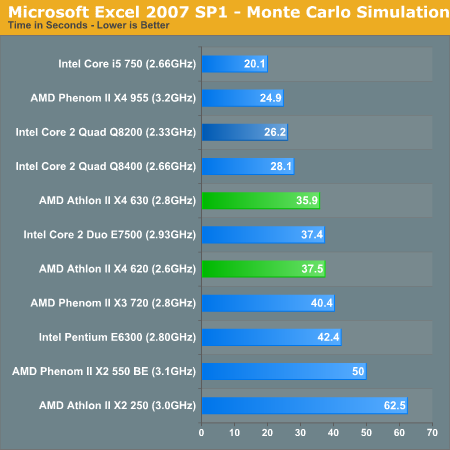
Like Blender, we have another highly optimized Intel case - but even here the Athlon II performs admirably. It's faster than the Phenom II X3 720, slower than the Q8200 but faster than the E7500.
It's priced like an Intel dual-core processor, but outperforms it in even the most Intel-favored situations.
Sony Vegas Pro 8: Blu-ray Disc Creation
Although technically a test simulating the creation of a Blu-ray disc, the majority of the time in our Sony Vegas Pro benchmark is spent encoding the 25Mbps MPEG-2 video stream and not actually creating the Blu-ray disc itself.
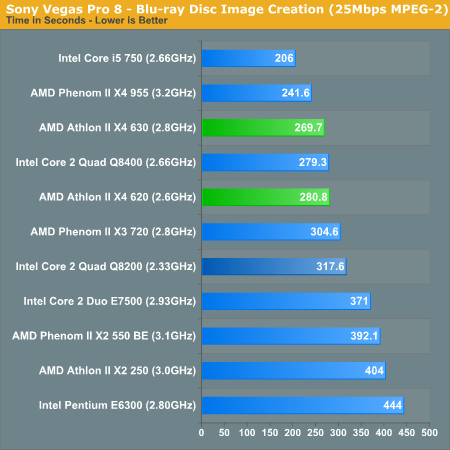
The Athlon II X4 620 goes back to delivering the goods. Faster than a Q8200 and an X3 720 once more.
Sorenson Squeeze: FLV Creation
Another video related benchmark, we're using Sorenson Squeeze to convert regular videos into Flash videos for use on websites.
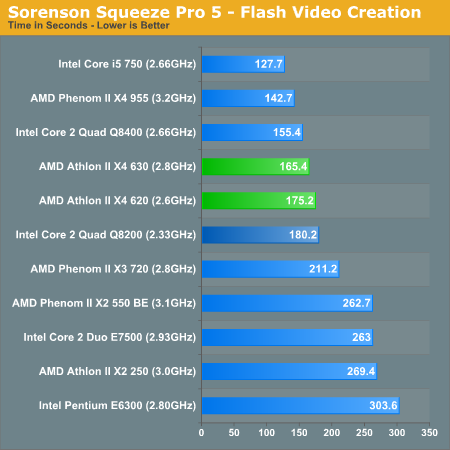
More of the same here.
PAR2 Multithreaded Archive Recovery Performance
Par2 is an application used for reconstructing downloaded archives. It can generate parity data from a given archive and later use it to recover the archive
Chuchusoft took the source code of par2cmdline 0.4 and parallelized it using Intel’s Threading Building Blocks 2.1. The result is a version of par2cmdline that can spawn multiple threads to repair par2 archives. For this test we took a 708MB archive, corrupted nearly 60MB of it, and used the multithreaded par2cmdline to recover it. The scores reported are the repair and recover time in seconds.
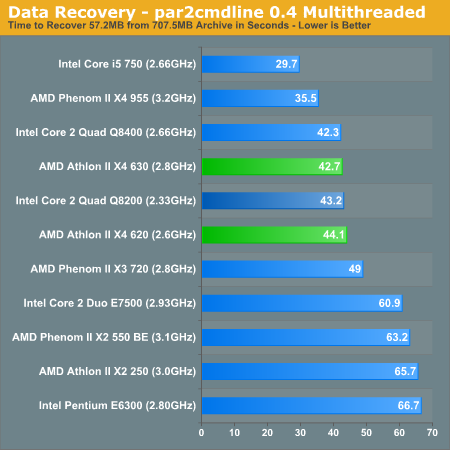
Par2 is healthily threaded so the Athlon II X4s continue to do well here. The Q8200 inches by the 620, but for all intents and purposes it's the same speed as the $99 fighter from AMD.
WinRAR - Archive Creation
Our WinRAR test simply takes 300MB of files and compresses them into a single RAR archive using the application's default settings. We're not doing anything exotic here, just looking at the impact of CPU performance on creating an archive:
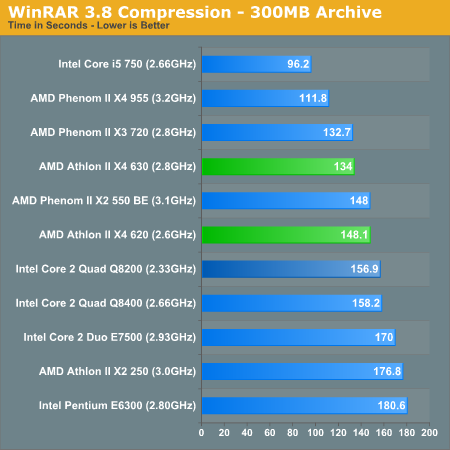
The roles are reversed here, and all of the AMD architectures prove faster than their similarly priced Intel alternatives.
Fallout 3 Game Performance
Bethesda’s latest game uses an updated version of the Gamebryo engine (Oblivion). This benchmark takes place immediately outside Vault 101. The character walks away from the vault through the Springvale ruins. The benchmark is measured manually using FRAPS.
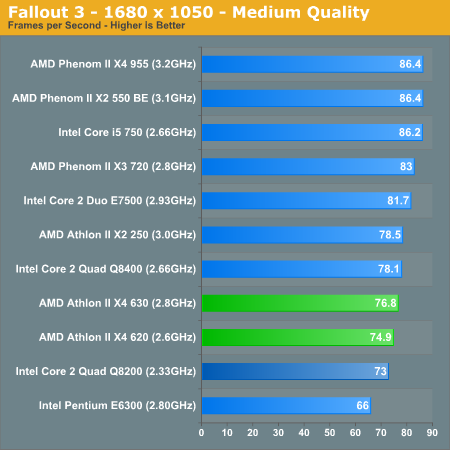
Will $99 get you a potent gaming processor? Compared to anything similarly priced, yes, yes it will. If you're building a gaming box you're still better suited for todays games with a faster dual-core processor but if you care about multithreaded performance elsewhere, the X4 won't disappoint.
Left 4 Dead
Zombies? Check. Zombie killing performance:

If this thing only had Lynnfield's turbo modes it would be at the top of these charts. We get respectable performance out of the Athlon II X4s, just nothing earth shattering.
FarCry 2 Multithreaded Game Performance
FarCry 2 ships with the most impressive benchmark tool we’ve ever seen in a PC game. Part of this is due to the fact that Ubisoft actually tapped a number of hardware sites (AnandTech included) from around the world to aid in the planning for the benchmark.
For our purposes we ran the CPU benchmark included in the latest patch:
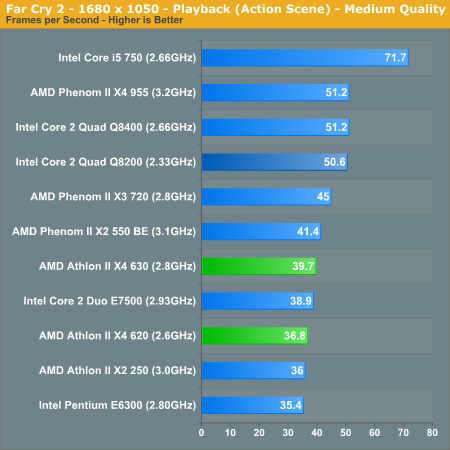
The FarCry 2 CPU bench seriously favors the Intel CPUs. This is the first and only time where the Athlon II X4 looks like it doesn't make sense. Given its success in the rest of the suite, I'll give it a pass.
Crysis Warhead

Faster than an E6300 (cheaper) but slower than a Q8200 (more expensive), the Athlon II X4 620 does very well given its price.
Power Consumption

Without power gating the Athlon II X4 draws as little power as possible, noticeably less than any of AMD's other multi-core CPUs. Our X4 620 sample was a bit more power hungry than our 630.
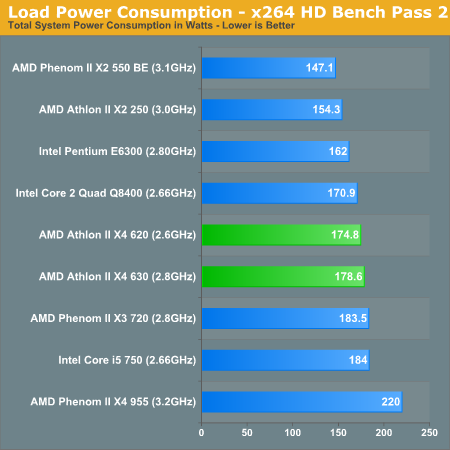
Even under load the power consumption story is a good one. Given the position of our Q8400 sample here we'd say that the Q8200 would probably use a bit less power, but the price differential should more than make up for it.
Overclocking
As I mentioned at the start of this article I managed to hit 3.25GHz on the Athlon II X4 620 without any additional voltage using the retail AMD cooler:

I could hit 260MHz x 13.0 for 3.38GHz by upping the voltage, but the gain wasn't worth the additional power usage. Anything higher wasn't possible without more exotic cooling or much more voltage. The performance improved handily at 3.25GHz:
| Processor | Adobe Photoshop CS4 | x264 2nd pass | Left 4 Dead |
| AMD Athlon II X4 620 (2.6GHz) | 27.5 seconds | 15.4 fps | 93.2 fps |
| AMD Athlon II X4 620 @ 3.25GHz | 23.2 seconds | 18.9 fps | 102.9 fps |
| AMD Phenom II X4 955 (3.2GHz) | 22.3 seconds | 19.1 fps | 121.4 fps |
| Intel Core 2 Quad Q8400 | 21.8 seconds | 17.9 fps | 105.6 fps |
At 3.25GHz the Athlon II X4 ends up faster than the even more expensive Q8400in some cases, and gets much closer in others. In applications where the large L3 cache isn't missed, the overclocked Athlon II can end up being a poor man's Phenom II X4 955. But looking at the Left 4 Dead performance, there's no such thing as a free lunch - the overclocked Athlon II isn't quite that good.
Final Words
Regardless of what it may seem like, this is not a repeat of AMD during the late K8 or during the Phenom days. AMD is relegated to competing in the sub-$200 space, it is actually very competitive in that space. These days, I'm sure that's not a bad position to be in. While I'm sure AMD would love to be able to demand more money for its processors, being able to demand any at all isn't a bad position to be in.
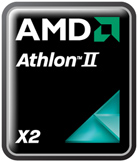
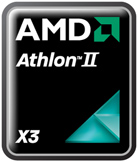
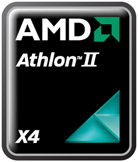
The Athlon II X4 620: Doing the Athlon Brand Justice
AMD effectively knocked 40% off the value of Intel's low end quad-core CPUs. The Athlon II X4 620 manages to, at $99, perform close enough to the Core 2 Quad Q8200 that the latter simply doesn't make any sense. Add another hundred dollars and you'll get a Core i5 750 (or less will get you into a Phenom II X4 945/955), but if you're on a strict budget you can't beat the 620.
The 630 I'm less excited about simply because it commands a 22% price premium. What the 620 has going for it is its sub-$100 entry price; start going much above that then you might as well be looking at a Phenom II X3.
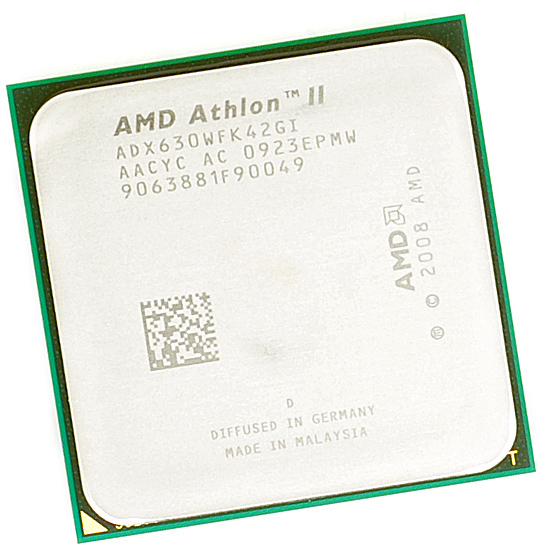
In the Phenom generation AMD fought off Intel's dual cores with its own triple cores. This time AMD is fighting off Intel's dual cores with quad cores. It's clever positioning and aggressive pricing that AMD will have to employ in order to make it until Bulldozer and Fusion hit.







